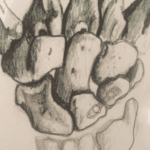Introduction
Fibrous dysplasia is a benign (noncancerous) bone condition in which abnormal fibrous tissue replaces normal bone. As the fibrous tissue grows and expands, this can lead to bone weakening, fractures, and deformities.
While some patients with fibrous dysplasia show few or no symptoms, others may experience severe effects, significantly when multiple bones are affected. In severe cases, surgery might be needed to remove affected bone areas and address fractures or deformities.
Description
Fibrous dysplasia is a rare condition that accounts for about 7% of all benign bone tumours. It can affect any bone but is most commonly found in the femur, tibia, ribs, skull, humerus, and pelvis. The condition is linked to a gene mutation that causes abnormal fibrous bone formation. Although it starts before birth, it often goes undetected until childhood, adolescence, or adulthood.
There are two main types of fibrous dysplasia:
- Monostotic fibrous dysplasia: Only one bone is affected, making it the most common form.
- Polyostotic fibrous dysplasia: Multiple bones are involved, often leading to more severe symptoms and earlier detection.
Fibrous dysplasia is a chronic and often progressive disorder. Lesions may stabilise over time but do not disappear. The polyostotic form and lesions in growing children tend to progress more rapidly.
In some cases, fibrous dysplasia can cause hormonal abnormalities, leading to additional symptoms.
This condition can also be part of more extensive disorders like McCune-Albright syndrome, which includes polyostotic fibrous dysplasia, hormonal abnormalities, and café au lait spots on the skin.
Malignant transformation of fibrous dysplasia is very rare, occurring in less than 1% of cases, and is more likely in patients with the polyostotic form or McCune-Albright syndrome.
Cause
The gene mutation causing fibrous dysplasia is not inherited and has no known link to diet or environmental factors. It occurs equally in males and females of all races.
Symptoms
Symptoms vary based on the size and severity of the lesions. Lesions can be painless and asymptomatic, discovered incidentally during X-rays for unrelated conditions.
When symptoms occur, they may include:
- Pain: As fibrous tissue grows, it can cause a dull ache, worsening with activity and alleviating with rest.
- Fracture: Weakened fibrous bone can fracture easily, often after a period of dull pain or suddenly without prior pain.
- Bone Deformity: Repeated fractures and poor healing can lead to deformities, particularly noticeable in facial and leg bones. These can potentially cause vision or hearing loss, difficulty walking, or arthritis in nearby joints.
- Hormonal Disturbances: Hormonal abnormalities can cause early puberty, thyroid hyperactivity, adrenal gland hyperactivity, pituitary gland issues, and parathyroid gland dysfunction.
- Skin Discoloration: Café au lait spots are common in patients with hormonal abnormalities and fibrous dysplasia.Rarely, fibrous dysplasia can become cancerous, indicated by rapid lesion growth, increasing swelling, and persistent pain.
Clinical Examination
During the examination, your doctor will discuss your general health, medical history, and symptoms.
Tests
- X-rays can reveal abnormal bone areas resembling ground glass, bone expansion, and deformities.
- Other Imaging Studies: MRI and CT scans provide detailed views of lesions and can help identify fractures or cancerous changes.
- Bone Scan: This detects additional lesions by highlighting areas of abnormal bone activity using radioactive dye.
- Laboratory Tests: Blood and urine tests may show elevated enzyme levels indicative of active lesions, but these results are not specific to fibrous dysplasia.
- Biopsy: A tissue sample from the lesion, examined under a microscope, confirms the diagnosis. This can be done with a needle or as a minor surgical procedure.
Treatment
Nonsurgical Treatment
- Observation: Asymptomatic Monitoring lesions.
- Medications: Bisphosphonates can reduce pain and fracture frequency by decreasing bone-resorbing cell activity.
- Bracing: It prevents fractures in weakened bones, although it does not prevent deformity progression.
Surgical Treatment
Surgery may be required to remove lesions or fix/prevent fractures. Surgical options include:
- Curettage: Scraping out the tumour.
- Bone Graft: Filling the cavity with bone from a donor, the patient’s body, or synthetic materials.
- Internal Fixation: Using metal rods, plates, and screws to stabilise the bone.
Research on the Horizon
Genetic research aims to understand better the mutation causing fibrous dysplasia, potentially leading to more effective nonsurgical treatments. New medications, such as advanced bisphosphonates and denosumab, are easier to use and have fewer side effects, offering hope for improved treatment options




